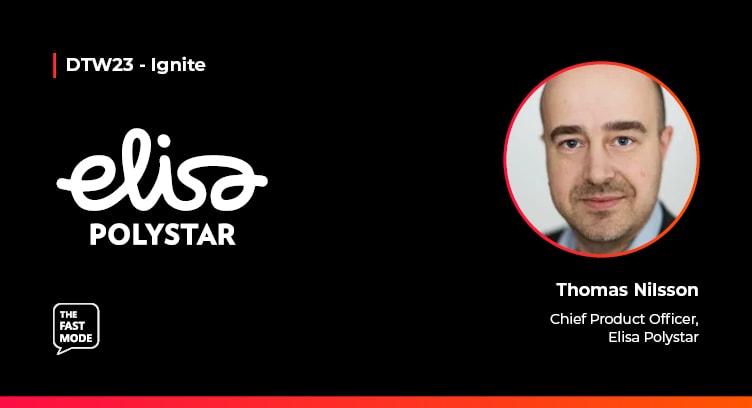In the run-up to DTW23 - Ignite, Ariana Lynn, Principal Analyst at The Fast Mode spoke to Thomas Nilsson, Chief Product Officer, Elisa Polystar. Thomas discusses his predictions for the next year, the growth of artificial intelligence as well as his thoughts on open digital architectures.
Ariana: What are some emerging trends and technologies that you expect will power digital transformation in the telco space in the next year?
Thomas: In essence there are four key areas: Adoption of 5G Standalone services; the implementation of DataOps and mesh architectures to enable data as a product concepts; network automation; and AI.
With some exceptions, adoption of 5G Standalone (SA) has been slower than expected. That’s mainly because operators have hesitated to launch 5G SA services without a clear monetization strategy. However, we’re starting to see real trials and expect to see more services based on the network slicing capability provided by 5G SA. These are important steps towards enhanced transformation and digitalisation of the network, moving to a more advanced, dynamic environment. As part of this work, operators will digitalise their processes to order, activate and assure quality of service. We also see operators beginning to implement edge processing, growing adoption of SDN, cloud RAN, Open RAN, and more. The adoption of these technologies forces operators to review and digitalise their current processes, to fully capitalise on the enhanced performance and innovation they bring.
Operators are actively reviewing their existing assurance stack, so that they can collect and make sense of all the data being generated in the network. Part of this strategy is to implement DataOps and mesh, providing accurate, high quality and timely data to all relevant stakeholders in the organisation. Accurate and timely data, giving a complete picture of network performance, service delivery and how users of operator services experience them is a crucial step to build trust, and be prepared to move to next step - which is network automation.
Network automation has been a hot subject for some time now, but we are now seeing operators taking concrete steps to automate their fault management and engineering processes. Moving from a manual process to automated processes is a complex task and many operators have spent quite some time thinking on how to do it. However, it can’t be avoided any longer – it’s now time to put network automation in motion. Our experience shows that automation can be implemented in a specific domain, as well as cross multiple domains, such as RAN & core in mobile network. While the ultimate outcome from network automation is to reduce OPEX & CAPEX, we see a parallel and emerging trend with customer experience also driving network automation.
AI has also been around for a while, but we anticipate the technology will become more visible in delivery of advanced use cases. Generative AI is of course a hot topic right now - and we will also see the adoption of the technology in many products.
Ariana: What are your thoughts on artificial intelligence (AI), specifically generative AI? Where is it heading?
Thomas: AI will be adopted everywhere as the power of the technology opens amazing new opportunities across many domains. For example, the ability to analyse and identify patterns in large volumes and varieties of data, which we can use to drive network automation decisions. The dynamic nature and increased complexity of new networks will also force us to utilise such technology in an ethical way. Yes, we need to derive insights to make sure the networks are utilised cost-effectively and to maximize uptime – but at the same time ensure that customer satisfaction is maintained to the expected level, and their data is protected.
Most suppliers and operators are exploring Generative AI at the moment, given the momentum gained during 2023. Clearly, it’s here to stay. While it is still a fairly new technology, we can already see that its adoption over the next few years will impact our current way of working and automate aspects of many roles - and there is no industry that will not be impacted from this. We will see suppliers and operators begin to embed the technology into products and other workflows, and expect many new announcements. We will probably also hear many users of the technology strive to ensure that it is used ethically.
Ariana: What are your thoughts on open digital architectures and what role do they play in supporting autonomous networks?
Thomas: Two key drivers behind autonomous networks are that operators should be able to deliver services faster - and cheaper.
While some services will be “static” and provided by all operators, operators also need to find new ways of differentiating from others. It is expected that multiple providers of applications, and services will be part of the operator ecosystem. If this is to work in practice, operators must make it easy for new entrants to join. This is true for both suppliers that exist in the operator future landscape of IT systems, as well as for providers of application and services that need access to operators’ connectivity networks. This can only happen if you have an ODA, with well-defined APIs to enable the easy addition and removal of processes, components, workflows, users, and more, as new services/applications are introduced to the network. Hence, ODA has a critical role in supporting autonomous networks.
Thomas Nilsson has over 20 years of experience from the telecommunication & IT industries. During his time in Elisa Polystar, he has held a number of management positions within the company, including Chief Technology Officer. As Chief Product Officer, Thomas oversees development of the entire Elisa Polystar product portfolio and outlines its strategy direction.




















